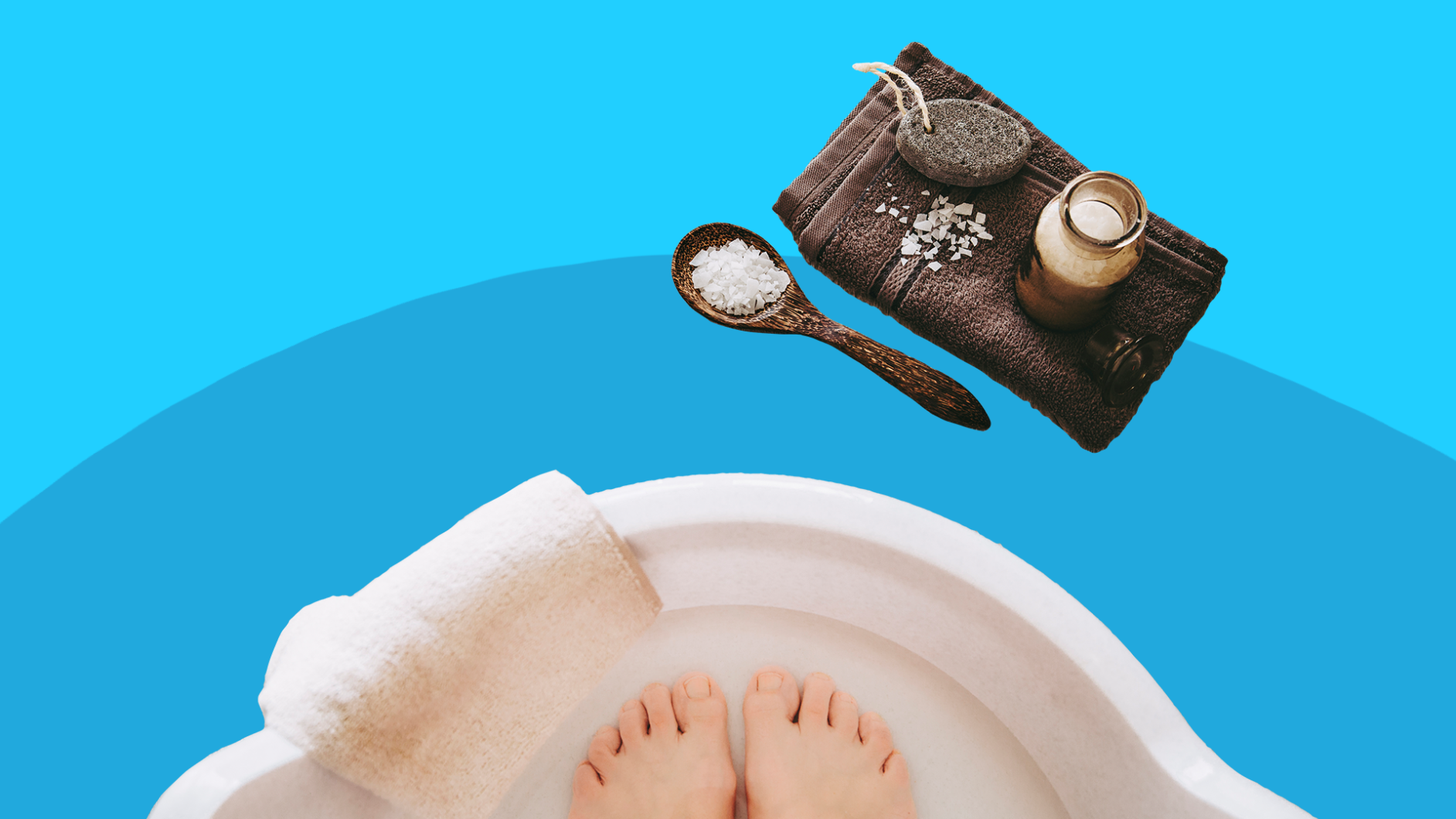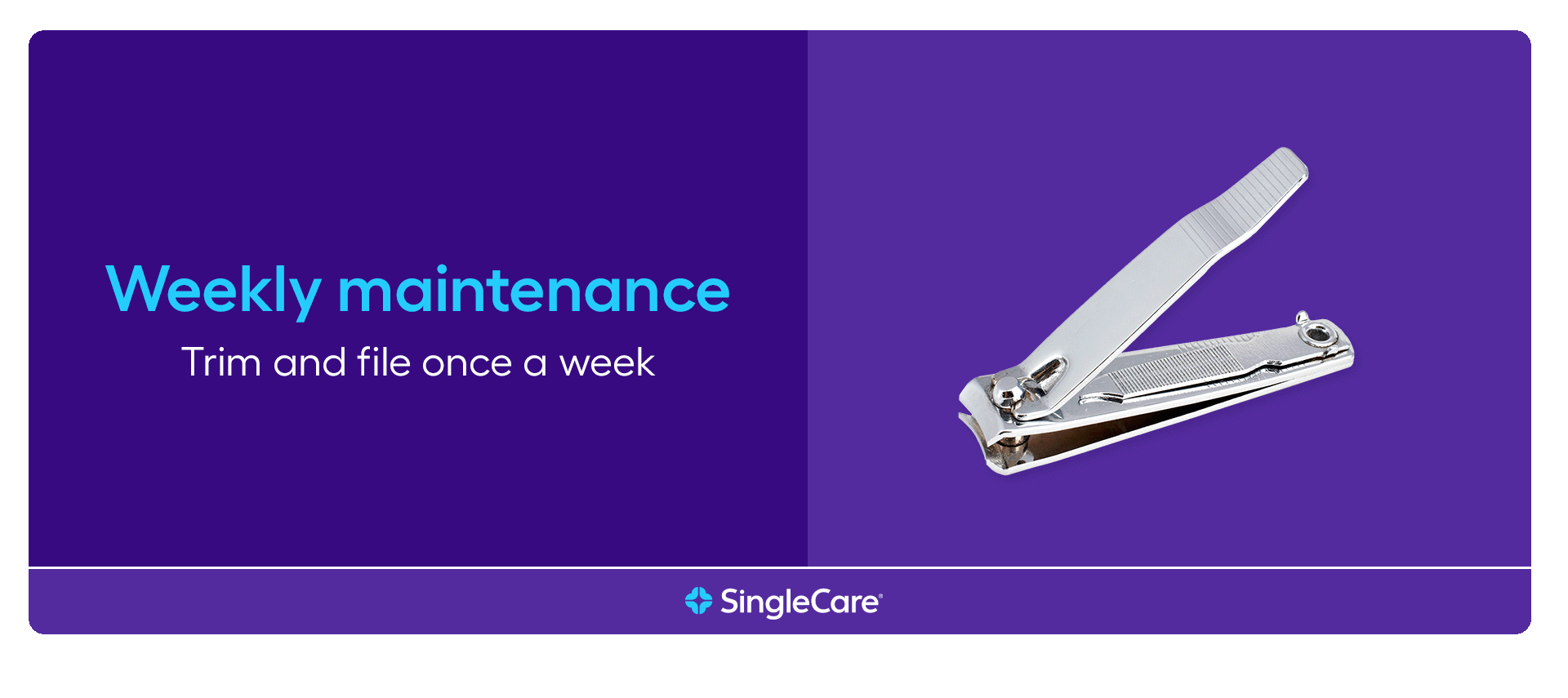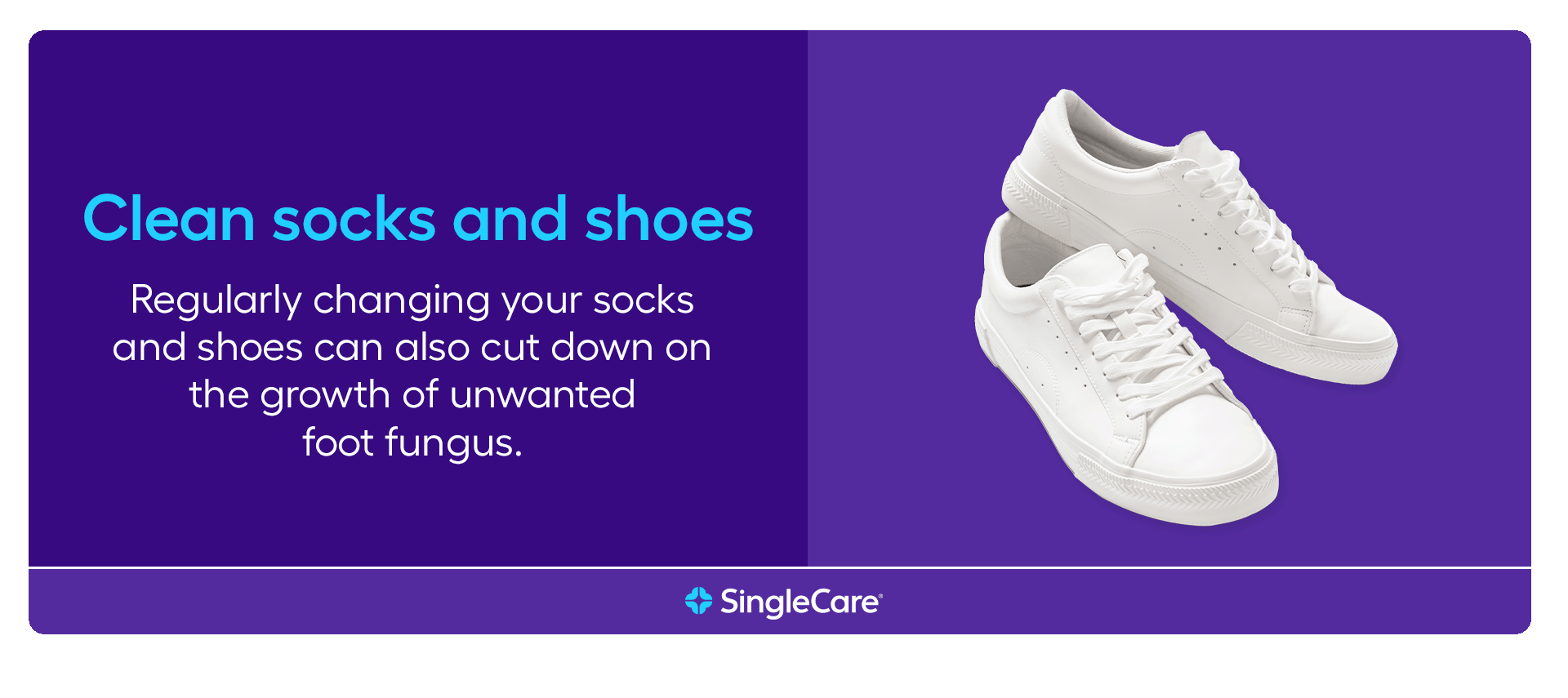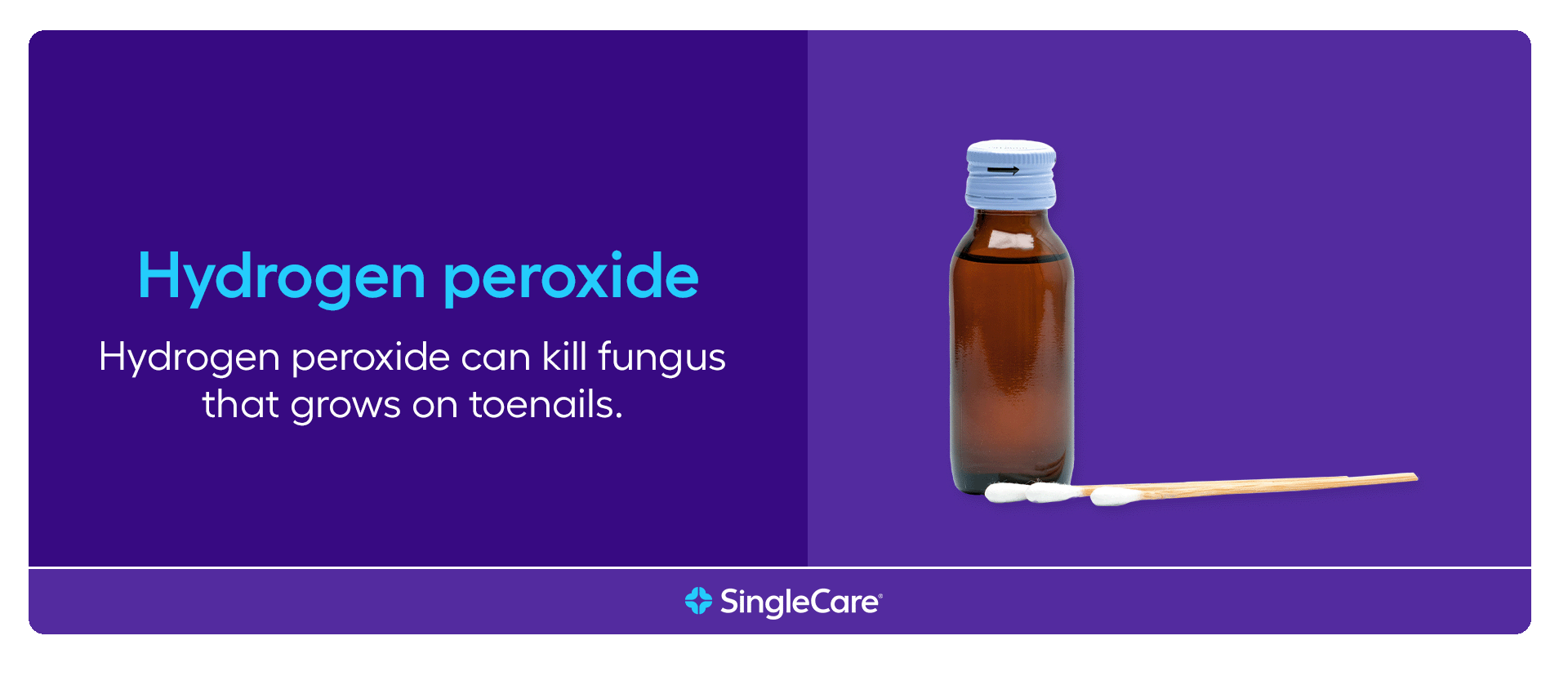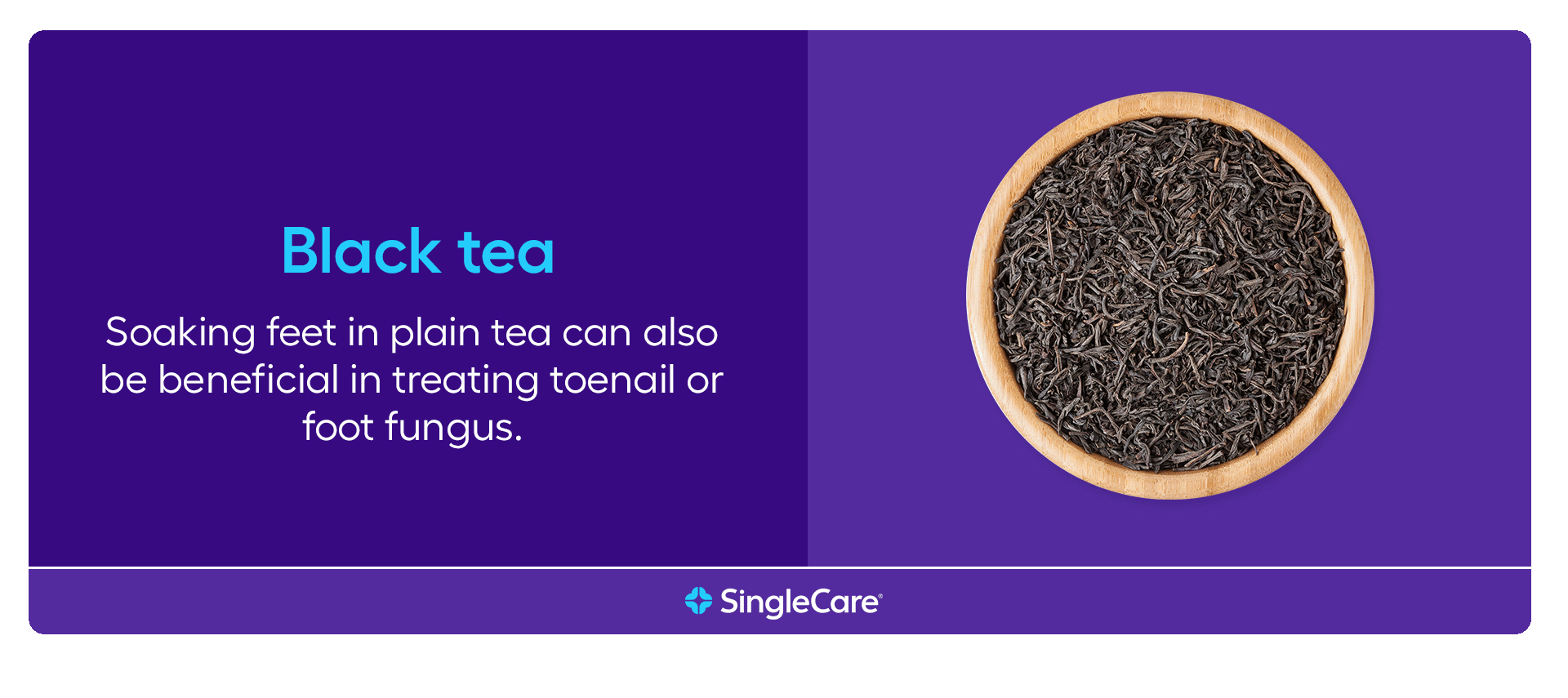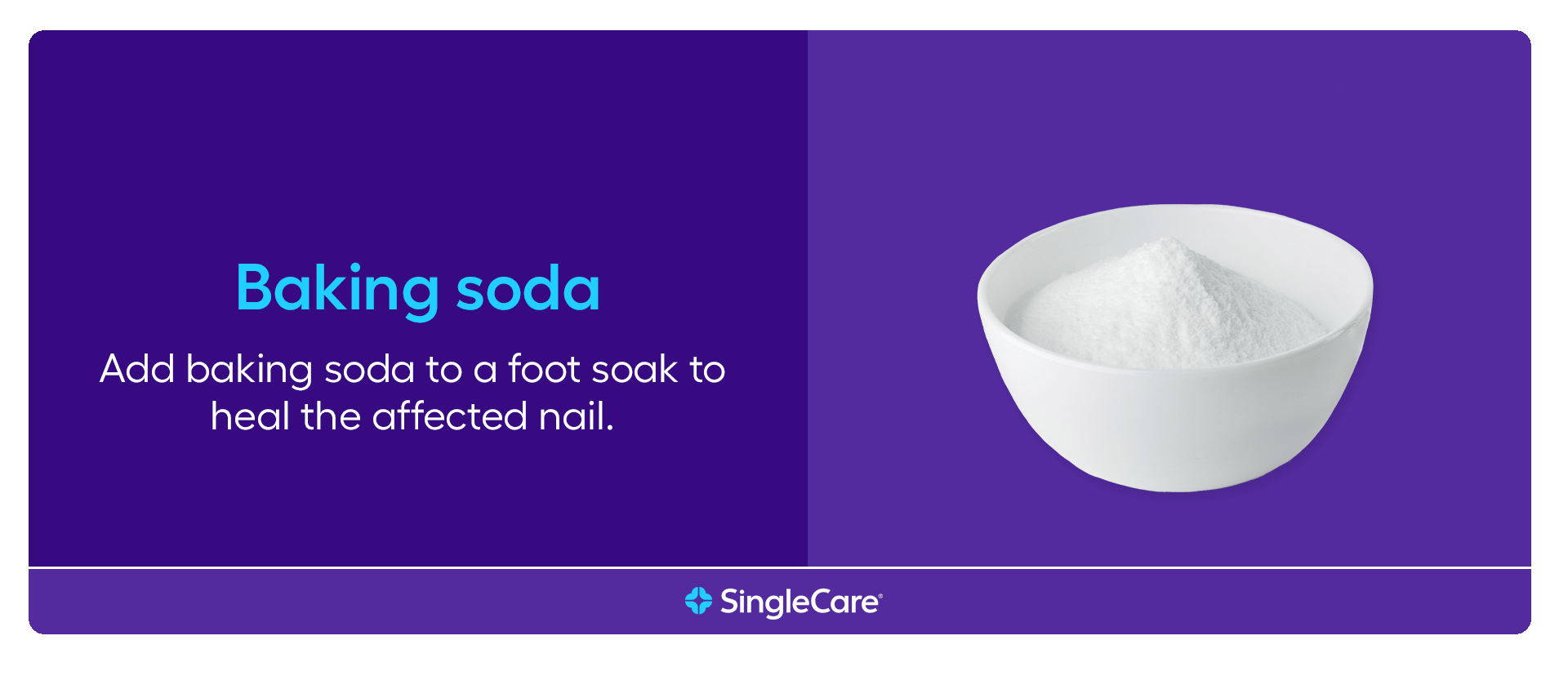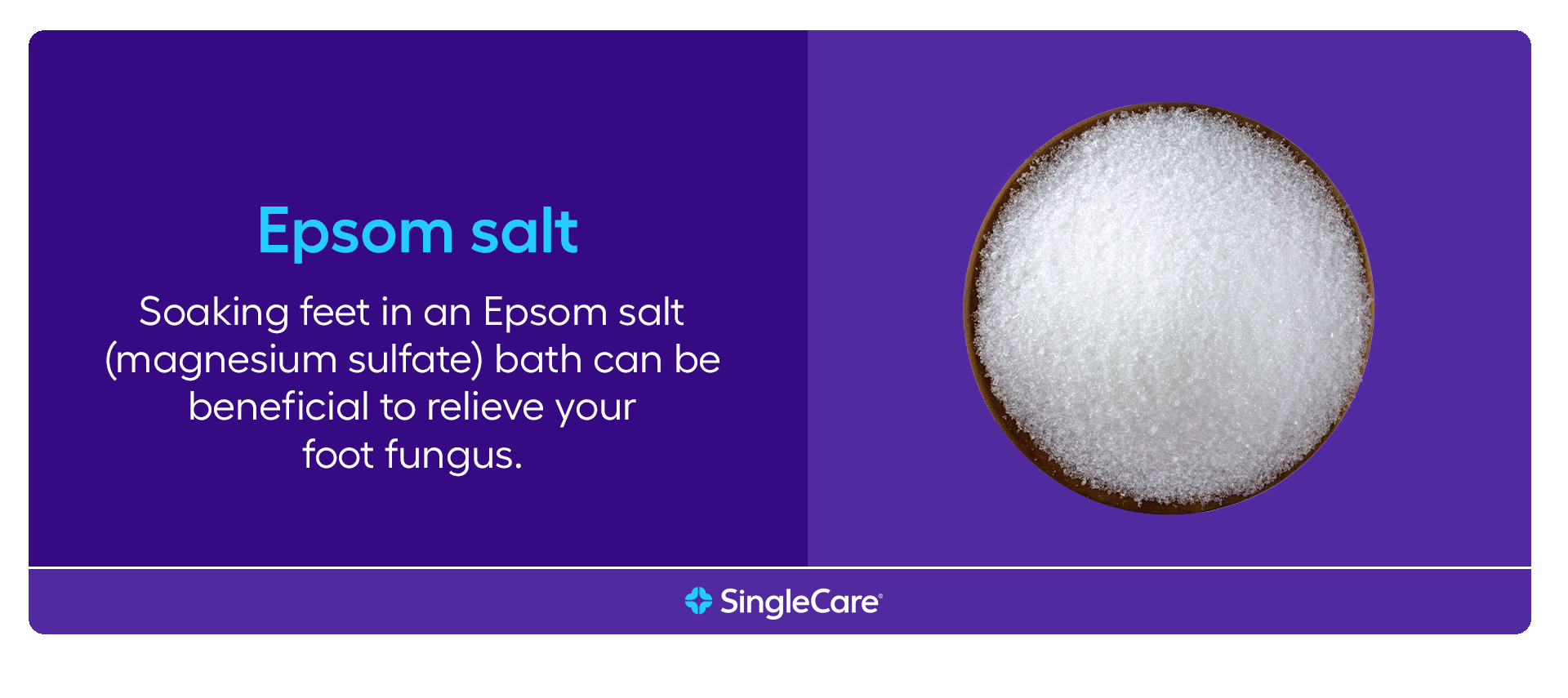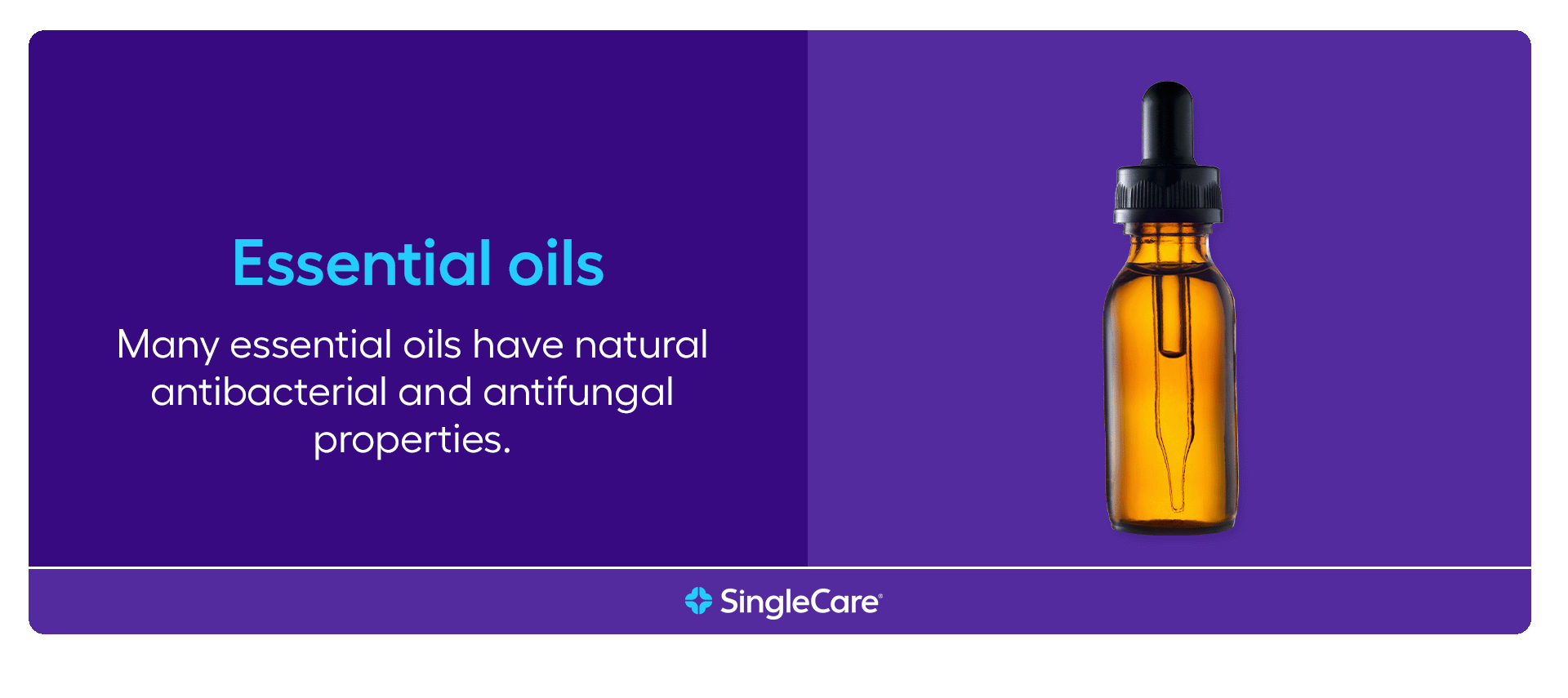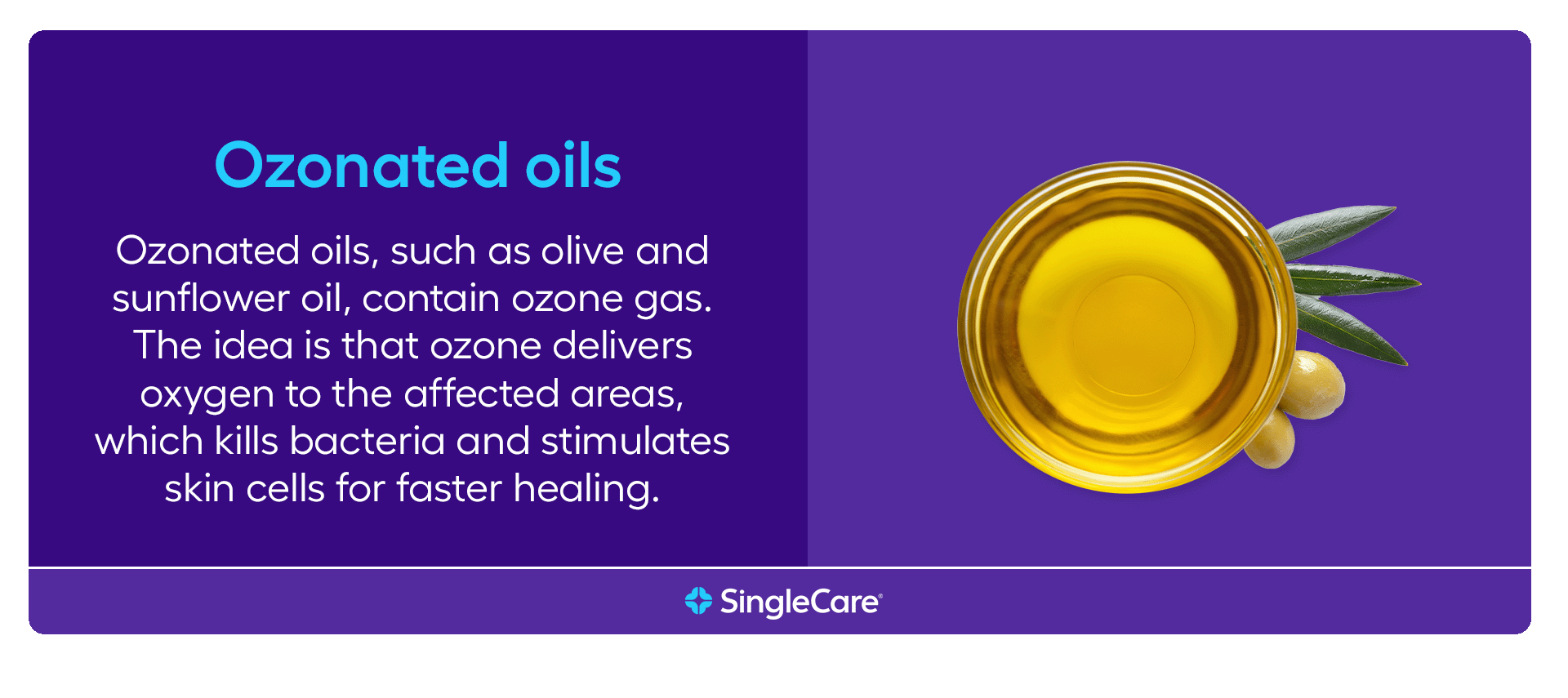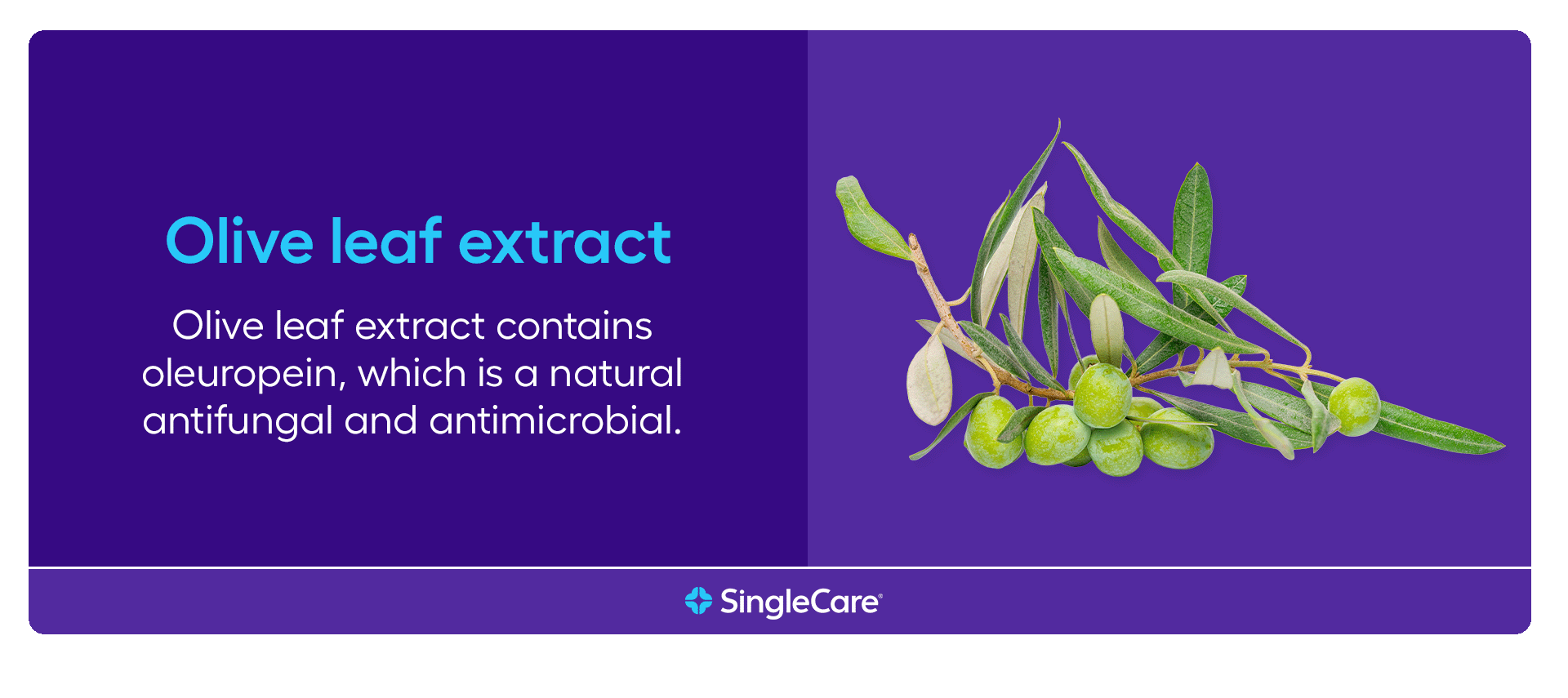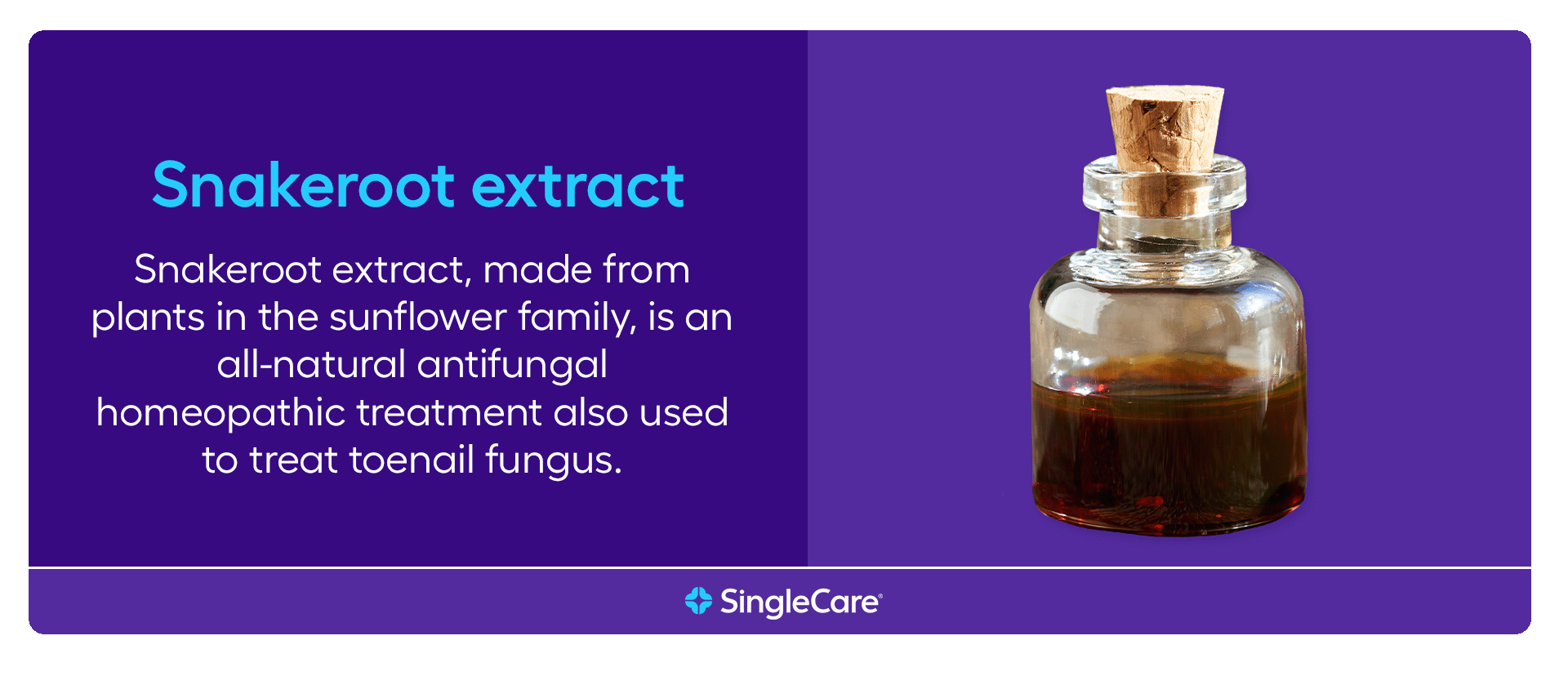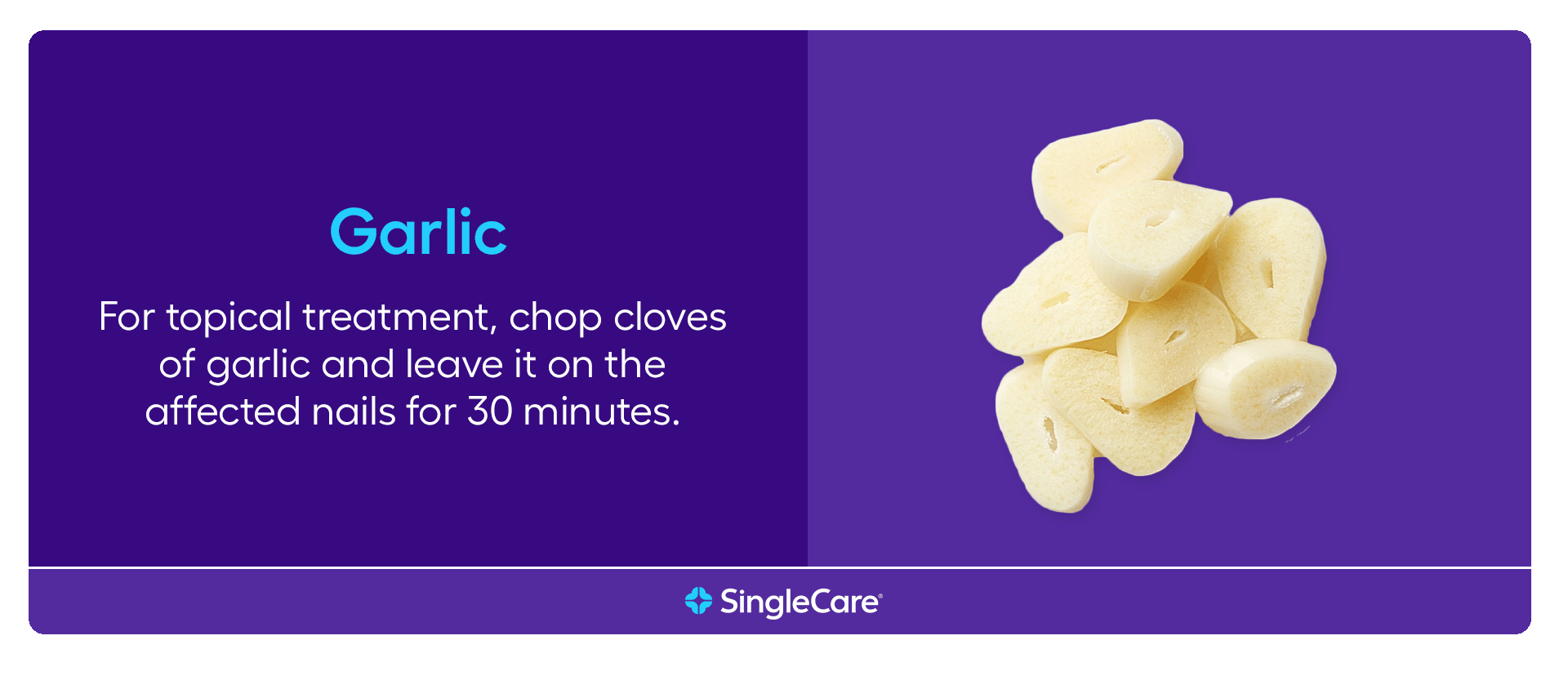Key takeaways
Toenail fungus, or onychomycosis, is caused by molds, yeasts, and fungi entering through cracked nails or skin. These organisms thrive in moist conditions.
Home remedies for toenail fungus include weekly nail maintenance and using hydrogen peroxide, vinegar, baking soda, and essential oils to reduce or eliminate the fungus.
Over-the-counter and prescription medications can help remedy toenail fungus that doesn’t improve with natural treatments. Laser therapy can help more stubborn cases.
Consult your healthcare provider if toenail fungus persists or causes pain to prevent serious complications. Taking this step is particularly important if you have diabetes.
Risk factors | Symptoms | Most popular home remedies | Unsafe home remedies | Over-the-counter medicine | Prescription drugs | Laser removal | When to see a doctor
Toenail fungus, also known as onychomycosis or tinea unguium, is a common nail condition affecting millions of people in the United States. Fungal nail infections can develop on the nail from various organisms such as molds, yeasts, and fungi. This usually occurs after these organisms come into contact with a cracked nail or skin surrounding the nail as the opening provides a portal of entry for fungal spores.
RELATED: Types of toenail fungus │Lotrimin Af Powder Coupons & Prices
Risk factors
When your feet sweat or remain moist or damp, the opportunity for the fungus to grow on your toenails increases. Frequent exposure to warm, moist environments such as swimming pools, locker rooms, or even living in a humid climate places you more at risk of developing these types of infections. This is also why these infections seem to be more prevalent during the sandal season.
Men have been known to develop toenail fungus infections more than women as well as individuals with weakened immune systems—people with diabetes, poor circulation, and older adults. Individuals who frequent nail salons (where supplies are not properly cleaned) may also be placing themselves at risk of developing and spreading fungal infections to their feet.
What does toenail fungus look like?
The most noticeable symptom of toenail fungus may be discoloration resulting in a white, yellow, brown, or even black toenail. The nail may become thickened, which makes it difficult for you to care for the nail on your own. Foul odor, brittleness, or even complete separation of the nail from the nail bed may be more evidence of infection.
In most cases, a fungal toenail infection usually does not cause pain unless the infection is severe. In some cases, the fungus can affect the foot as well, especially between the toes. This is called athlete’s foot.
What kills toenail fungus fast?
Unfortunately, there are no “quick fixes” when it comes to treating nail fungus. This is because a new toenail must grow to replace the old, damaged toenail. It can take a long time—up to 18 months—to regrow the toenail. This time frame varies on how fast or slow your toenails grow and how severe the fungal infection is.
RELATED: Nail fungus treatment and medications
Save up to 80% on Fluconazole with SingleCare
Different pharmacies offer different prices for the same medication. SingleCare helps find the best price for you.
15 best home remedies for toenail fungus
Many people would rather start with items they have around the house before purchasing medication or visiting their doctor’s office for mild toenail fungus. Try some of these effective home remedies for toenail fungus:
- Weekly maintenance
- Clean socks and shoes
- Hydrogen peroxide
- Black tea
- Vinegar
- Baking soda
- Epsom salt
- Essential oils
- Ozonated oils
- Olive leaf extract
- Snakeroot extract
- Garlic
- Cornmeal
- Diet improvements
- Exercise
1. Weekly maintenance
First, prepare your nails for treatment by trimming and filing them once a week. Clipping toenails relieves pressure on the nails and helps antifungal solutions penetrate the nail. Use traditional toenail clippers and an Emory board to keep nails short and thin. Make sure to disinfect utensils after each use. Maintaining trimmed, clean, and dry nails will be essential in treating toenail fungus and preventing it in the future.
2. Clean socks and shoes
Regularly changing your socks and shoes can also cut down on the growth of unwanted foot fungus. Both socks and athletic shoes can be washed to rid the growth of yeasts and fungi that may be growing on the fabric. Adding a half-cup of baking soda or one cup of vinegar to the washing machine can help eliminate bacteria and kill fungus in shoes and socks. Some shoes can be machine dried. Drying shoes in the sun is another option when cleaning footwear, but make sure they are completely dry before wearing them again.
Boots and other footwear that are not machine washable could be wiped out with a vinegar and water solution or sprayed with an over-the-counter (OTC) antifungal spray. Medicated antifungal powder for shoes is also helpful in treating shoes for foot fungus.
Allowing the feet to breathe by taking off shoes and socks when possible can prevent fungal growth. Protect your feet by wearing breathable footwear and clean, dry socks. Antimicrobial socks and shoes made from bamboo, copper, or specialty fabrics are also available. They can help reduce unwanted bacteria and yeast from growing in your footwear.
A proactive approach to keeping your feet clean and dry can prevent the spread of toenail fungus. You can wash or soak your feet with warm soapy water or a foot bath using everyday household items. Soaking your feet in an all-natural, homeopathic concoction can be beneficial in reducing or eliminating toenail fungus.
3. Hydrogen peroxide
Hydrogen peroxide can kill the fungus that grows on toenails. You can use hydrogen peroxide for toenail fungus by wiping it on your infected toes or toenails with a clean cloth or cotton swab. A hydrogen peroxide foot soak can also be used. Mix 1/8 cup of hydrogen peroxide (or several capfuls) to four cups of cool water and soak feet for 10 to 20 minutes. Rinse feet with warm water and pat dry.
4. Black tea
Soaking feet in plain tea can also be beneficial in treating toenail or foot fungus. Black tea contains tannic acid that dries out the feet, kills bacteria, and helps to close the foot’s pores to reduce sweating. Boil two quarts of water then add five to six tea bags. Allow the solution to cool and soak feet for 30 minutes. Use this foot soak daily if desired.
5. Soaking feet in vinegar
Another home remedy to treat toenail fungus includes the use of apple cider vinegar foot soak. Vinegar is an antifungal ingredient that can be mixed with water to create a foot soak. Its acetic acid component helps to whiten discolored toenails and stop the spread of the infection to other toes. Try one part vinegar to two parts warm water and soak feet for 20 minutes daily. If the smell is too overwhelming, a few drops of essential oils can be added to make the experience more pleasant. White vinegar can be used as an alternative as both are equally effective.
6. Baking soda
Add baking soda to a foot soak to try to heal the affected toenail. You can also make a paste of baking soda with a minimal amount of water and apply it directly to the foot. Allow the paste to sit on the affected area for 10 to 20 minutes, then rinse with warm water and dry the foot thoroughly.
Baking soda can also be sprinkled in shoes like foot powder. Sprinkle on some baking soda, then shake the shoes gently to distribute the powder. Let the shoes sit for at least 24 hours, then shake out any remaining baking soda.
You can also sprinkle baking soda onto the foot. Once applied to a dry foot, put on clean socks. Sodium bicarbonate, the active ingredient in baking soda, can wick away moisture while healing properties work to reduce toenail fungus.
7. Epsom salt
Soaking feet in an Epsom salt (magnesium sulfate) bath can be beneficial to relieve your foot fungus. You can mix one cup of Epsom salt with two quarts of warm to hot water and soak your feet for 10 to 20 minutes. You could also try a more elaborate Epsom salt concoction that includes:
- 4 cups warm to hot water
- 1/2 cup Epsom salt
- 1/2 cup baking soda
- 1/4 cup hydrogen peroxide
- 1/4 cup vinegar
Mix all of the ingredients and soak feet for 15 to 20 minutes. A few drops of essential oils are a great addition to foot baths. Essential oils with healing properties to treat foot fungus are listed below. Following your foot soak, rinse your feet with clean water and pat dry with a clean towel. To avoid contaminating clean feet, put on clean socks and breathable shoes following your foot bath.
8. Essential oils
Essential oils are popular home remedies for a variety of common ailments. Many essential oils have natural antifungal and antibacterial properties. Some essential oils that could help reduce toenail fungus include:
- Tea tree oil
- Clove oil
- Clary sage oil
- Lavender oil
- Eucalyptus oil
- Cinnamon oil
- Lemon oil
- Lemongrass oil
- Lime oil
- Thieves oil
- Wild oregano oil
- Manuka tree oil
Dilute essential oils with a carrier oil, such as coconut oil or olive oil, before applying them to the skin. Mix the desired oil or combination of oils with a carrier oil of your choice and apply a few drops to the affected nail. As previously mentioned, you can also add two to three drops of essential oils to footbaths.
9. Ozonated oils
Ozonated oils, such as olive and sunflower oil, contain ozone gas. The idea is that ozone delivers oxygen to the affected areas, which kills bacteria and stimulates skin cells for faster healing. One study found that ozonated oil is an effective home remedy for toenail fungus caused by certain strains. Researchers tested ozonized sunflower oil on 101 samples of yeast. The oil was an effective treatment against several fungal strains. To try this remedy, clean and dry your foot first. Gently massage a small amount of ozonated oil into the skin, working it into the affected nails and around the entire toe.
10. Olive leaf extract
Olive leaf extract contains oleuropein, which is a natural antifungal and antimicrobial. A salve made from olive leaves can be applied to the toenails to reduce infection. Or, you can take oral capsules containing the extract to try to boost the immune system and treat toenail fungus systemically. Consult your healthcare provider before taking olive leaf extract. The dosing varies by formulation.
11. Snakeroot extract
Snakeroot extract, made from plants in the sunflower family, is an all-natural antifungal homeopathic treatment also used to treat toenail fungus. Commonly used in Ayurvedic practices in India, snakeroot extract can be applied directly to the affected toenail. Apply the extract two to three times a week for several months. Ask your healthcare provider if snakeroot extract is right for your type of fungus.
12. Garlic
Garlic is a potent antimicrobial plant. For topical treatment, chop cloves of garlic and leave them on the affected nails for 30 minutes daily for a week. Use raw garlic sparingly, as it can result in a chemical burn.
Ask a pharmacist about herbal supplements that contain garlic. These supplements can be taken orally to not only treat skin infections but also can help high blood pressure, heart disease, certain cancers, and lower the risk of tick bites. Garlic supplements should not be taken by people with stomach ulcers, digestion problems, or bleeding disorders. It might also make birth control pills less effective. Talk to a healthcare professional before taking oral garlic supplements.
13. Cornmeal
Cornmeal has some antifungal properties. You can try cornmeal as a weekly home remedy for toenail fungus.
You can try applying cornmeal as a paste or a soak. For a paste, dissolve cornmeal in warm water in a shallow pan. Let the paste cool before using it on your feet. Let it sit for an hour.
As a soak, add an inch of cornmeal to a shallow container. Pour an inch of warm water on top of the cornmeal, letting the cornmeal and water mix naturally for an hour. Then, after an hour, add enough warm water to cover your entire foot and let it soak for an hour.
14. Diet
Your current diet could be feeding fungus caused by Candida overgrowth. Here are some diet changes you can make to starve the yeast and improve toenail fungus:
- Cut out sugar
- Don’t drink alcohol
- Limit refined carbohydrates such as white bread, cookies, and cereal
- Cook with coconut oil
- Incorporate ginger and garlic
- Supplement with a probiotic
15. Exercise
Regular exercise can expedite the healing process. As blood pumps faster through the body, it releases natural vitamins and flushes toxins. Just be sure to practice proper hygiene to avoid making toenail fungus worse. Wear socks that wick away excess moisture, use antifungal foot powder, remove shoes and socks immediately after a workout to let feet breathe, and wear flip-flops or sandals in communal areas like shower rooms or pools. Remember to wash your feet with antibacterial soap and completely dry your feet after your shower.
How to know if toenail fungus is dying
Many at-home treatments quickly improve the appearance of the nail, but the actual fungus is not gone until the new, healthy nail has replaced the old, damaged one.
Unsafe natural remedies for toenail fungus
Although there are many effective home remedies for toenail fungus, there are still some natural treatments and household products that can cause more harm than good. For example, you should never use bleach to get rid of toenail fungus. Its use may be toxic to the skin and cause severe skin irritation when not used properly.
Additionally, you should never use overly hot water when performing the variety of foot soaks mentioned above. Excessive heat to the nails and skin will not kill fungus—and extreme temperatures may injure the skin causing burns, blisters, and sometimes permanent skin damage. Always use lukewarm water for soaking.
Urine is another home remedy that should be avoided. Previously, it had been believed to be effective against fungal infections due to its urea contents. While urea can help soften the nail bed to make it easier for antifungal medication to be absorbed, urine does not contain enough urea to be effective.
And, finally, do not remove or excessively trim toenails at home. Fungal toenails should be properly trimmed and maintained regularly, but do not remove too much nail. If toenail clipping or removal is not done properly, damage to the nail bed may cause additional injury to the nail, which can be irreversible. There also is the risk of causing bacterial infections when the damaged nail is not removed properly.
If the natural remedies for toenail fungus listed above do not work, there are other effective treatments for toenail fungus available at your local pharmacy.
Over-the-counter toenail fungus treatment options
While home treatments can be the cure you are looking for to treat toenail fungus, they’re not regulated or approved by the U.S. Food and Drug Administration (FDA). Over-the-counter antifungal creams, lotions, sprays, and even medicated nail polish are available. Home remedies can often enhance the efficacy of these products.
Vicks VapoRub
One of the more popular over-the-counter remedies for treating toenail fungus is using Vicks VapoRub. Mentholated topical ointments contain the natural ingredients menthol, oil of eucalyptus, and camphor. Use Vicks alone or in conjunction with other treatments and medications. Clean feet and apply a small amount of Vicks VapoRub daily.
Listerine
Soaking an infected nail in the OTC product Listerine can also help reduce or kill toenail fungus, due to its antifungal and antimicrobial activity. Commonly used as a mouthwash, Listerine applied to the affected toe or toenail for 20 minutes twice a day can effectively reduce signs of onychomycosis. Alternatively, you can make a foot bath with Listerine, using equal parts warm water and Listerine and adding one cup of Epsom salts.
Athlete’s foot medication
Athlete’s foot sprays, powders, and creams help stop fungal growth before it develops on the toenail or surrounding flesh. Brand-name products that you can purchase without a prescription include Tinactin (tolnaftate), Micatin (miconazole), Lamisil (terbinafine), and Lotrimin AF (clotrimazole).
Vitamin E
Both topical and oral vitamin E supplements are linked to improving the appearance of yellow nails as well as accelerating nail growth. Vitamin E is an antioxidant that can protect and improve the aging process in our cells. This treatment can strengthen, hydrate, and repair discolored toenails. Topically it can be applied to the nails and surrounding skin twice a day. Although it may improve the appearance of the nails, it can not kill a fungal infection as there are no antifungal properties in vitamin E.
RELATED: Athlete’s foot treatments and medications
Toenail fungus prescriptions
Sometimes prescription medications are needed to treat a toenail infection that just won’t go away with natural remedies or over-the-counter medication in a few months. In this case, prescription-strength antifungal agents can eradicate stubborn onychomycosis.
Topical antifungal medications often are effective in treating mild to moderate toenail fungus. Topical solutions may include medicated nail polishes or liquid medications. Penlac (ciclopirox), Kerydin (tavaborole), and Jublia (efinaconazole) are among the top prescription drugs for toenail fungus. Some topical medications require you to file down the surface of the nail to help the treatment get through to the nail bed. If your healthcare provider prescribes a topical medication, follow the instructions carefully for application and removal.
Oral antifungal medications can come in capsules, tablets, or liquid. Some common prescriptions are Diflucan (fluconazole), Lamisil (terbinafine), Onmel (itraconazole), and Sporanox (itraconazole).
| Toenail fungus prescriptions | ||
|---|---|---|
| Penlac (ciclopirox) | Coupons | Learn more |
| Kerydin (tavaborole) | Coupons | Learn more |
| Jublia (efinaconazole) | Coupons | Learn more |
| Diflucan (fluconazole) | Coupons | Learn more |
| Lamisil (terbinafine) | Coupons | Learn more |
| Onmel (itraconazole) | Coupons | Learn more |
| Sporanox (itraconazole) | Coupons | Learn more |
Side effects of toenail fungus medication
One of the many benefits of using homeopathic treatments is that there are little to no adverse reactions. Topical treatments often prescribed to treat toenail fungus can potentially burn or blister the skin. Oral medications for treating onychomycosis can cause liver or gastrointestinal damage. Allergic reactions are also serious side effects that can result from any remedy or medication.
Other medical treatments
You can ask your doctor about other types of procedures or treatments. One popular option is laser therapy. There are several FDA-approved devices. However, laser therapy usually requires several sessions over time and may be expensive (and currently is not covered by insurance).
When to see a doctor about toenail fungus
If you are experiencing persistent toenail fungus or pain is present, you may need to schedule an appointment with a specialist. A dermatologist or podiatrist will assess your symptoms and may send a small sample of the affected toenail or flesh to a laboratory to be analyzed as various types of fungi and yeasts cause onychomycosis. Knowing the specific cause of your foot fungus can help identify the best treatment of toenail fungus.
Nail changes can also be caused by underlying conditions, like psoriasis and diabetes, so it’s important to seek professional medical advice if your condition persists or worsens. Bacterial and fungal infections of the skin in diabetes patients often result in hospital admissions, and in severe cases, can result in amputations. If you are at a higher risk for infection, you should skip home remedies and seek professional medical treatment.
Lea este artículo en español aquí.
- Fungal Nail Infections, Centers for Disease Control and Prevention (2022)
- A Paradigm Shift in the Treatment and Management of Onychomycosis, Skin Appendage Disorders (2021)
- Hydrogen peroxide in dermatology, Indian Journal of Dermatology, Venereology and Leprology (2021)
- Functional Properties of Vinegar, Concise Reviews in Food Science
- An Open Study to Evaluate Effectiveness and Tolerability of a Nail Oil Composed of Vitamin E and Essential Oils in Mild to Moderate Distal Subungual Onychomycosis, Skin Appendage Disorders (2020)
- “In vitro” antifungal activity of ozonized sunflower oil on yeasts from onychomycosis, Brazilian Journal of Microbiology (2012)
- Olive Leaf Extract, Designs for Health
- Onychomycosis: Current Trends in Diagnosis and Treatment, American Family Physician (2013)
- An examination of antibacterial and antifungal properties of constituents described in traditional Ulster cures and remedies, Ulster Medical Group (2009)
- When Vitamin And Nutritional Deficiencies Cause Skin And Nail Changes, Podiatry Today (2015)
- Over-the-counter and natural remedies for onychomycosis: do they really work? Cutis (2016)
- Novel Treatment of Onychomycosis using Over-the-Counter Mentholated Ointment: A Clinical Case Series, Journal of the American Board of Family Medicine (2011)
- Onychomycosis, Virginia Commonwealth University Health Services




